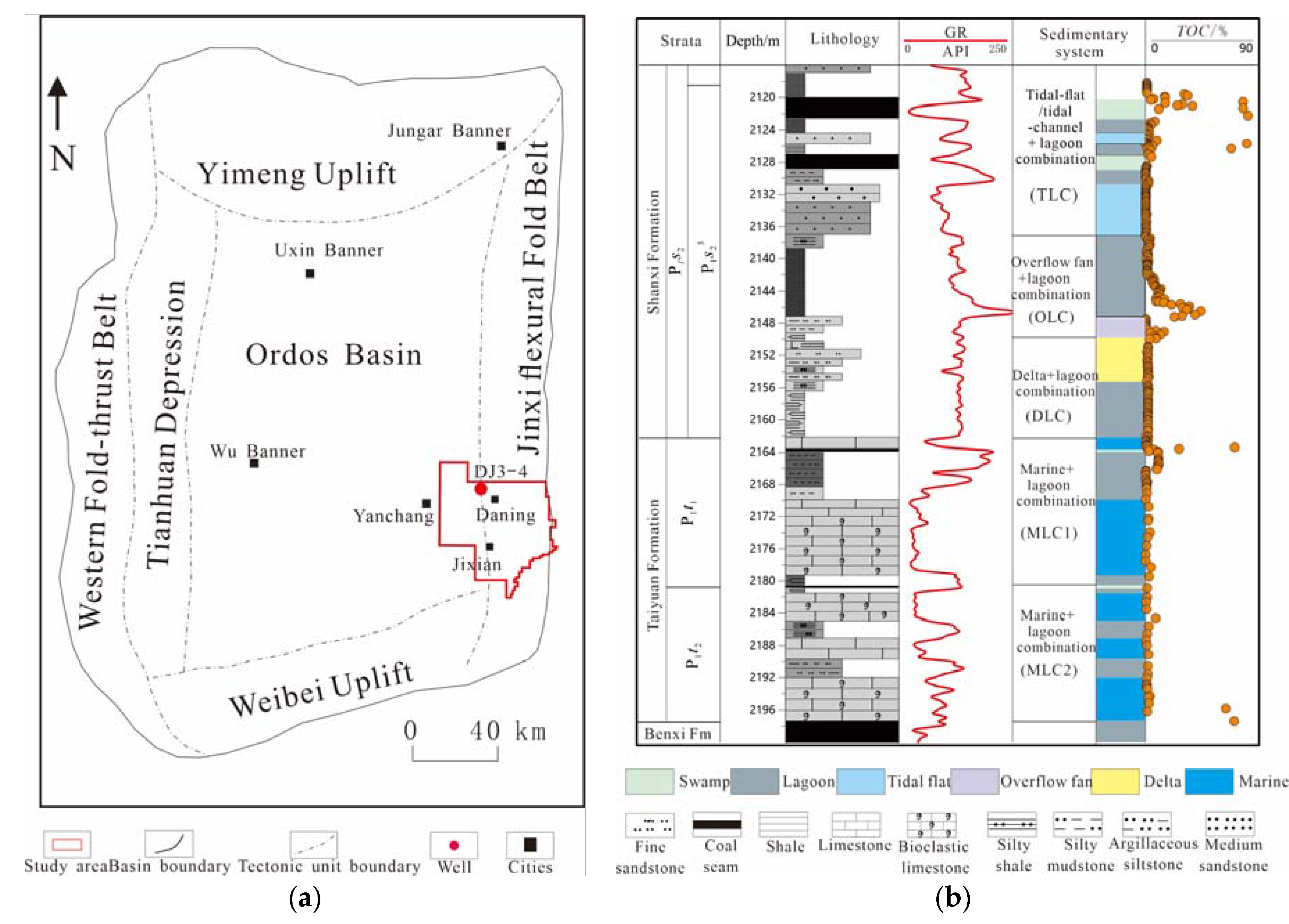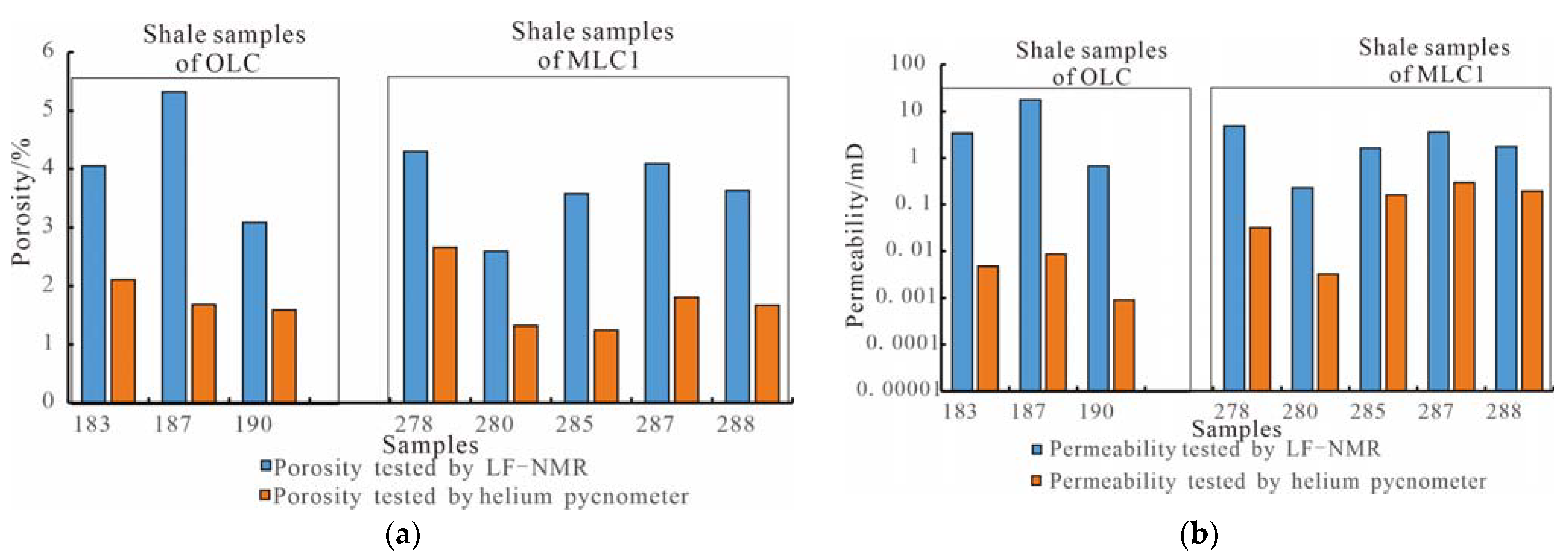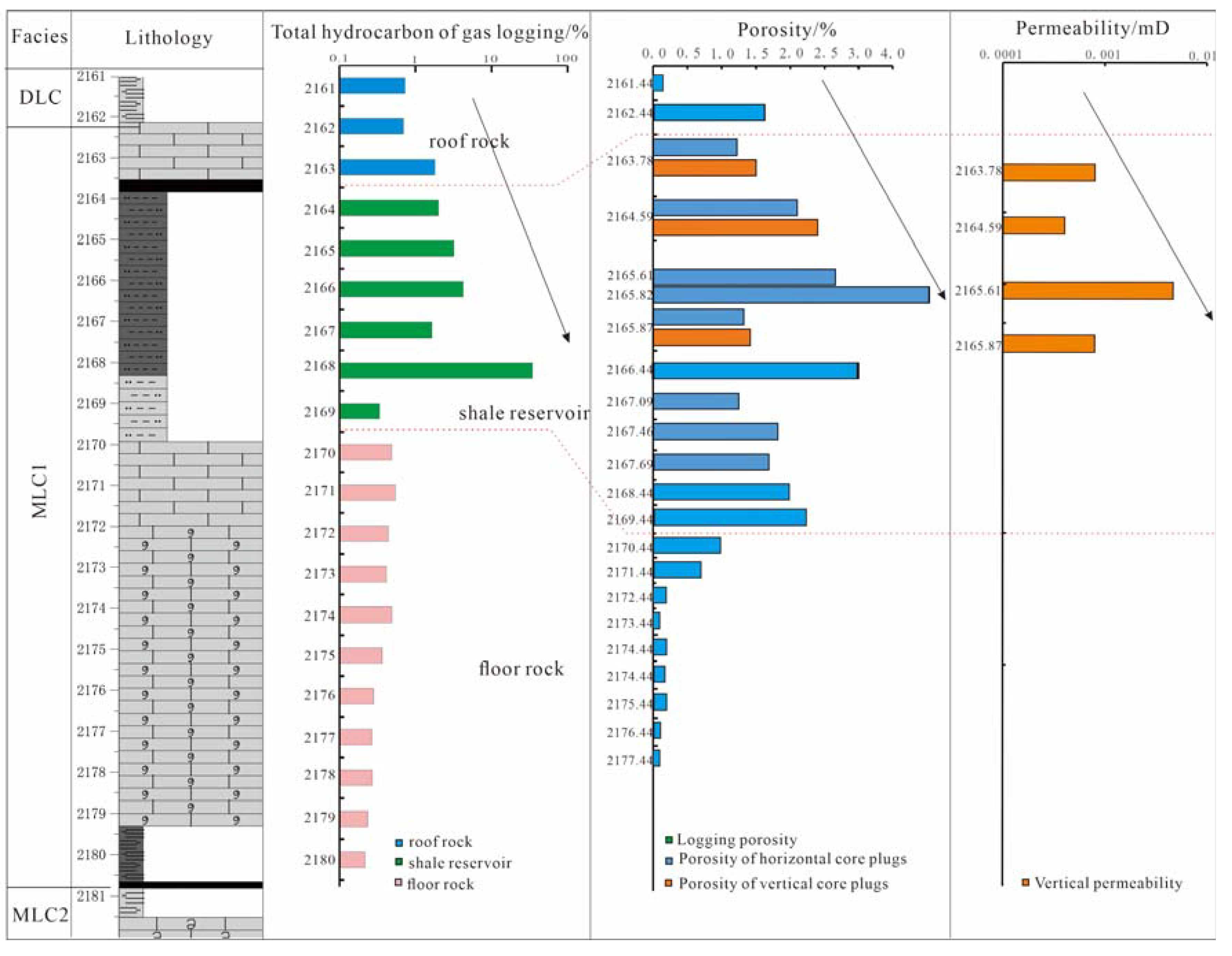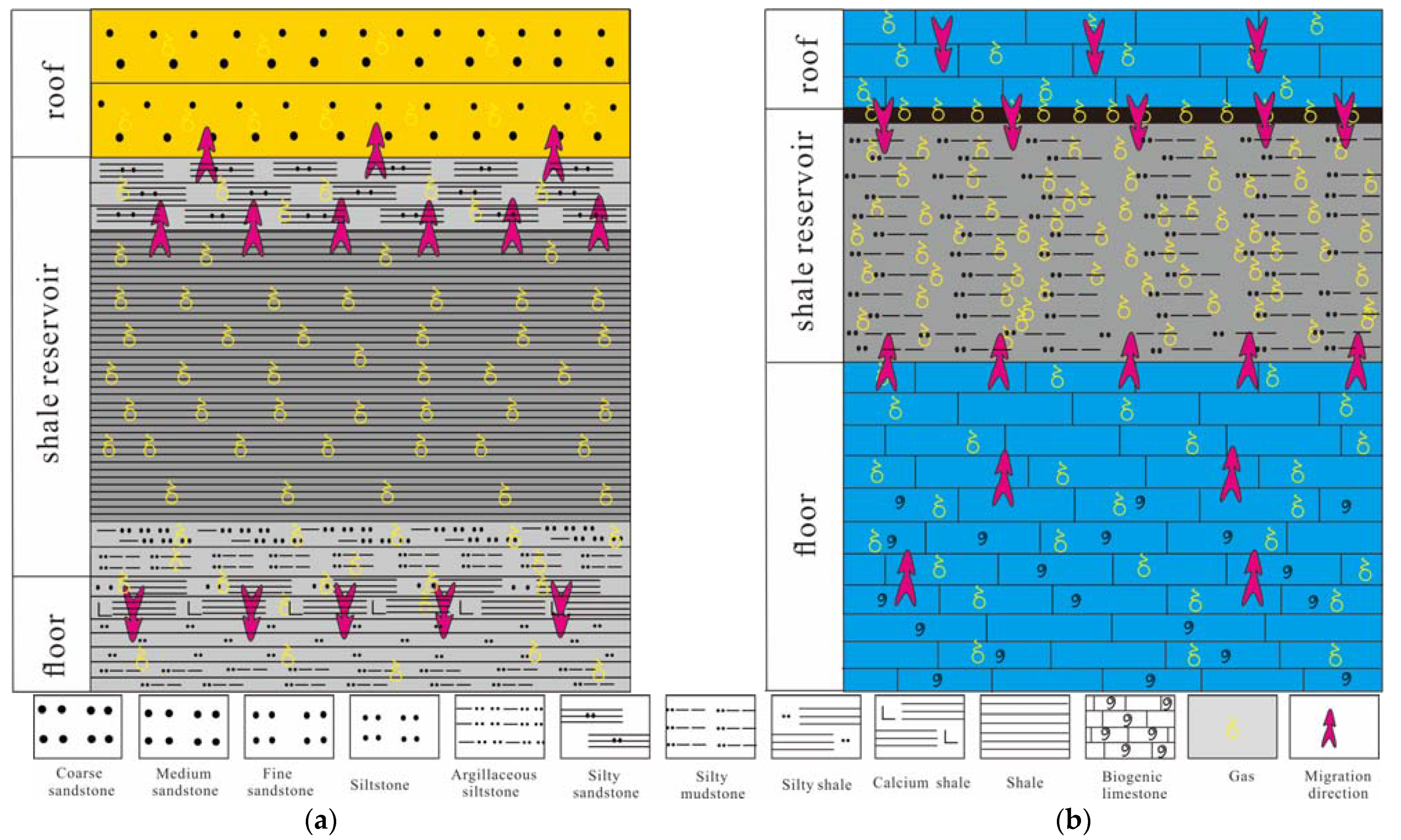Discussion on Transitional Shale Gas Accumulation Conditions from the Perspective of Source-Reservoir-Caprock Controlling Hydrocarbon: Examples from Permian Shanxi Formation and Taiyuan Formation in the Eastern Margin of Ordos Basin, NW China
Abstract
:1. Introduction
2. Geological Setting
3. Materials and Methods
3.1. Samples
3.2. Experiments
3.2.1. Geochemistry
3.2.2. Mineral Composition
3.2.3. Physical Properties
3.2.4. Pore Structure
4. Results
4.1. Geochemical Characteristics
4.1.1. TOC
4.1.2. Ro
4.2. Reservoir Characteristics
4.2.1. Mineralogy
4.2.2. Porosity and Permeability
4.2.3. BET Surface Area and BJH Pore Volume
4.3. Brittleness
5. Discussion
5.1. Sealing and Preservation Conditions
5.1.1. Regional Caprock
5.1.2. Direct Caprock
5.2. Shale Gas Accumulation Model for Both OLC and MLC1
5.3. Significance to the Shale Gas Exploration and Development
6. Conclusions
- (1)
- There are three lagoon facies combinations in P1s23, among which OLC has the highest TOC and is the optimal interval for shale gas enrichment in P1s23. There are two lagoon facies combinations in the Taiyuan Formation, among which MLC1 is the optimal interval for shale gas enrichment.
- (2)
- The reservoir physical characteristics of OLC and MLC1 are similar, but the shale in MLC1 is more brittle than that in OLC, indicating that MLC1 is more likely to form a complex fracture network when being fractured.
- (3)
- Due to the different lithologies, the preservation conditions of MLC1 is more superior for shale gas retention, which makes the gas content in MLC1 much higher and more favorable for shale gas exploration.
- (4)
- For transitional shale gas exploration, it is necessary to compare the hydrocarbon generation, reservoir storage, and preservation conditions among different lithologic combinations and single out the most suitable combination for transitional shale gas exploration.
Author Contributions
Funding
Institutional Review Board Statement
Informed Consent Statement
Data Availability Statement
Conflicts of Interest
References
- Zou, C.N.; Dong, D.Z.; Wang, Y.; Li, X.; Huang, J.; Wang, S.; Guan, Q.; Zhang, C.; Wang, H.; Liu, H. Shale gas in China: Characteristics, challenges and prospects (I). Pet. Explor. Dev. 2015, 42, 689–701. [Google Scholar]
- Zou, C.N.; Dong, D.Z.; Wang, Y.; Li, X.; Huang, J.; Wang, S.; Guan, Q.; Zhang, C.; Wang, H.; Liu, H. Shale gas in China: Characteristics, challenges and prospects (II). Pet. Explor. Dev. 2016, 43, 166–178. [Google Scholar]
- Ma, X.H. Natural gas and energy revolution: A case study of Sichuan-Chongqing gas province. Nat. Gas Ind. B 2017, 37, 91–99. [Google Scholar]
- Ma, X.H.; Xie, J. The progress and prospects of shale gas exploration and exploitation in southern Sichuan Basin, NW China. Pet. Explor. Dev. 2018, 45, 161–169. [Google Scholar]
- Ma, X.H.; Xie, J.; Yong, R. Geological characteristics and high production control factors of shale gas in Silurian Longmaxi Formation, southern Sichuan Basin, SW China. Pet. Explor. Dev. 2020, 47, 901–915. [Google Scholar]
- Li, L.G. Development of natural gas industry in China: Review and prospect. Nat. Gas Ind. 2021, 41, 187–196. [Google Scholar]
- Tang, X.; Zhang, J.C.; Ding, W.L.; Yu, B.S.; Wag, L.; Ma, Y.L.; Yang, Y.T.; Chen, H.Y.; Huang, H.; Zhao, P.W. The reservoir property of the Upper Paleozoic marine-continental transitional shale gans its gas-bearing capacity in the Southeastern Ordos Basin. Earth Sci. Front. 2016, 23, 147–157. [Google Scholar]
- Zou, C.N.; Zhao, Q.; Dong, D.Z.; Yang, Z.; Qiu, Z.; Liang, F.; Wang, N.; Huang, Y.; Duan, A.X.; Zhang, Q.; et al. Geological characteristics, main challenges and future prospect of shale gas. Nat. Gas Geosci. 2017, 2, 1781–1796. [Google Scholar]
- Kuang, L.C.; Dong, D.Z.; He, W.Y.; Wen, S.M.; Sun, S.S.; Li, S.X.; Qiu, Z.; Liao, X.W.; Li, Y.; Wu, J.; et al. Geological characteristics and development potential of transitional shale gas in the east margin of the Ordos Basin, NW China. Pet. Explor. Dev. 2020, 47, 435–446. [Google Scholar]
- Dong, D.Z.; Qiu, Z.; Zhang, L.F.; Li, S.X.; Zhang, Q.; Li, X.T.; Zhang, S.R.; Liu, H.L.; Wang, Y.M. Progress on sedimentology of transitional facies and new discoveries of shale gas. Acta Sedimentol. Sin. 2021, 39, 29–45. [Google Scholar]
- Feng, Z.Q. Characteristics and Evaluation of the Organic-Rich Shale of Shanxi Formation, Southeast in Ordos Basin. Master’s Thesis, China University of Geosciences, Beijing, China, 2014. [Google Scholar]
- Zhao, K.Y.; Guo, S.B. Characteristics and main controlling factors of shale gas reservoirs in transitional facies: A case study of Upper Paleozoic in Ordos Basin. Pet. Geol. Exp. 2015, 37, 141–149. [Google Scholar]
- Yang, C.; Zhang, J.C.; Han, S.B.; Wang, X.Z.; Wang, L.; Yu, W.W.; Wang, Z.G. Compositional controls on pore-size distribution by nitrogen adsorption technique in the Lower Permian Shanxi Shales, Ordos Basin. J. Nat. Gas Sci. Eng. 2016, 34, 1369–1381. [Google Scholar]
- Sun, Z.P.; Wang, Y.L.; Wei, Z.F.; Zhang, M.F.; Wang, G.; Wang, Z.X.; Zhuo, S.G.; Xu, L. Shale gas content and geochemical characteristics of marine-continental transitional shale: A case from the Shanxi formation of Ordos Basin. J. China Univ. Min. Technol. 2017, 46, 859–868. [Google Scholar]
- Xiong, F.Y.; Jiang, Z.X.; Li, P.; Wang, X.Z.; Bi, H.; Li, Y.R.; Wang, Z.Y.; Amooir, M.; Soltanian, M.R.; Moortgat, J. Pore structure of transitional shales in the Ordos Basin, NW China: Effects of composition on gas storage capacity. Fuel 2017, 206, 504–515. [Google Scholar]
- Liu, H.L.; Wang, H.C.; Zhang, H.; Zhao, W.B.; Liu, Y.; Liu, D.X. Geological characteristics and exploration countermeasures of shale gas in the Shanxi Formation of the Ordos basin. Acta Geol. Sin. 2020, 94, 905–915. [Google Scholar]
- Dai, J.X.; Zou, C.N.; Dong, D.Z.; Ni, Y.Y.; Wu, W.; Gong, D.Y.; Wang, Y.M.; Huang, S.P.; Huang, J.L.; Fang, C.C.; et al. Geochemical characteristics of marine and terrestrial shale gas in China. Mar. Pet. Geol. 2016, 76, 444–463. [Google Scholar]
- Wang, J.; Guo, S. The whole-aperture pore-structure characteristics of marine-continental transitional shale facies of the Taiyuan and Shanxi Formations in the Qinshui Basin, North China. Interpretation 2019, 7, T547–T563. [Google Scholar]
- Xue, C.Q.; Wu, J.G.; Qiu, L.W.; Zhong, J.H.; Zhang, S.R.; Zhang, B.; Wu, X.; Hao, B. Lithofacies classification and its controls on the pore structure distribution in Permian transitional shale in the northeastern Ordos Basin, China. J. Pet. Sci. Eng. 2020, 195, 107657. [Google Scholar]
- Chen, Y.H.; Wang, Y.B.; Guo, M.Q.; Wu, H.Y.; Li, J.; Wu, W.T.; Zhao, J.Z. Differential enrichment mechanism of organic matters in the marine-continental transitional shale in northeastern Ordos Basin, China: Control of sedimentary environments. J. Nat. Gas Sci. Eng. 2020, 83, 103625. [Google Scholar]
- Wei, Z.F.; Wang, Y.L.; Wang, G.; Zhang, T.; He, W.; Ma, X.Y.; Yu, X.L. Enrichment Mechanism of the Upper Carboniferous-Lower Permian Transitional Shale in the East Margin of the Ordos Basin, China: Evidence from Geochemical Proxies. Geofluids 2020, 2020, 8867140. [Google Scholar] [CrossRef]
- Zhang, L.F.; Dong, D.Z.; Qiu, Z.; Wu, C.J.; Zhang, Q.; Wang, Y.M.; Liu, D.X.; Deng, Z.; Zhou, S.W.; Pan, S.Q. Sedimentology and geochemistry of Carboniferous-Permian marine-continental transitional shales in the eastern Ordos Basin, North China. Palaeogeogr. Palaeoclimatol. Palaeoecol. 2021, 571, 110389. [Google Scholar]
- Gu, Y.F.; Cai, G.Y.; Li, S.X.; Jiang, Y.Q.; Qiu, Z.; Sun, S.S.; Fu., Y.H. Pore structure and controlling factors of different lithofacies in transitional shale: A case study of the Shanxi Formation Shan23 submember, eastern Ordos Basin. Acta Sedimentol. Sin. 2023, 41, 318–332. [Google Scholar]
- Qin, Y.; Liang, J.S.; Shen, J.; Liu, Y.H.; Wang, C.W. Gas logging shows and gas reservoir types in tight sandstones and shales from southern Qinshui Basin. J. China Coal Soc. 2014, 39, 1559–1565. [Google Scholar]
- Lan, C.L.; Guo, W.; Wang, Q.; Zhang, X. Shale gas accumulation condition and favorable area optimization of the Permian Shanxi Formation, Eastern Ordos Basin. Acta Geol. Sin. 2016, 90, 177–188. [Google Scholar]
- Gu, Y.F.; Li, X.T.; Qi, L.; Li, S.X.; Jiang, Y.Q.; Fu, Y.H.; Yang, X.S. Sedimentology and Geochemistry of the Lower Permian Shanxi Formation Shan 23 Submember Transitional Shale, Eastern Ordos Basin, North China. Front. Earth Sci. 2022, 10, 859845. [Google Scholar] [CrossRef]
- Wang, D.; Struck, U.; Ling, H.F.; Guo, Q.J.; Shields-Zhou, G.A.; Zhu, M.Y.; Yao, S.P. Marine redox variations and nitrogen cycle of the early Cambrian southern margin of the Yangtze Platform, South China: Evidence from nitrogen and organic carbon isotopes. Precambrian Res. 2015, 267, 209–226. [Google Scholar]
- Tian, D.; Harris, N.B.; Ayranci, K.; Twemlow, C.E.; Nassichuk, B.R. Porosity characteristics of the Devonian Horn River shale, Canada:Insights from lithofacies classification and shale composition. Int. J. Coal Geol. 2015, 141–142, 74–90. [Google Scholar]
- Yuan, Y.J.; Rezaee, R.; Verrall, M.; Hu, S.Y.; Zou, J.; Testmanti, N. Pore characterization and clay bound water assessment in shale with a combination of NMR and low-pressure nitrogen gas adsorption. Int. J. Coal Geol. 2018, 194, 11–21. [Google Scholar] [CrossRef]
- Sun, M.; Yu, B.; Hu, Q.; Chen, S.; Xia, W.; Ye, R. Nanoscale pore characteristics of the lower Cambrian Niutitang formation shale: A case study from well yuke #1 in the southeast of Chongqing, China. Int. J. Coal Geol. 2016, 154–155, 16–29. [Google Scholar] [CrossRef]
- Brunauer, S.; Emmett, P.H.; Teller, E. Adsorption of gases in multimolecular layers. J. Am. Chem. Soc. 1938, 60, 309–319. [Google Scholar]
- Barrett, E.P.; Joyner, L.G.; Halenda, P.P. The determination of pore volume and area distributions in porous substances. Computations from nitrogen isotherms. J. Am. Chem. Soc. 1951, 73, 373–380. [Google Scholar]
- Zhang, L.F.; Zhao, Q.; Wu, C.; Qiu, Z.; Zhang, Q.; Wang, Y.M.; Liu, D.; Dong, D.Z.; Zhou, S.W. Pore structures of the Lower Permian Taiyuan shale and limestone in the Ordos Basin and the significance to unconventional natural gas generation and storage. Geofluid 2022, 2022, 3156547. [Google Scholar] [CrossRef]
- Emerson, S.; Hedges, J.I. Processes controlling the organic carbon content of open ocean sediments. Paleoceanography 1988, 3, 621–634. [Google Scholar]
- Tian, W. Sedimentary System Study of Permian Shaanxi Formation in South-Eastern of Ordos Basin. Ph.D. Thesis, Northwest University, Xi’an, China, 2016. [Google Scholar]
- Zhu, R.X.; Chen, L.; Wu, F.Y.; Liu, J.L. Timing, scale and mechanism of the destruction of the North China Craton. Sci. China Earth Sci. 2011, 41, 789–797. [Google Scholar] [CrossRef]
- Zhang, L.F.; Zhao, Q.; Peng, S.Z.; Qiu, Z.; Feng, C.J.; Zhang, Q.; Wang, Y.M.; Dong, D.Z.; Zhou, S.W. Paleoenvironment and Organic Matter Accumulation Mechanism of Marine–Continental Transitional Shales:Outcrop Characterizations of the Carboniferous–Permian Strata, Ordos Basin, North China. Energies 2021, 14, 7445. [Google Scholar] [CrossRef]
- Nie, H.K.; Jin, Z.J.; Bian, R.K.; Du, W. The “source-cap hydrocarbon-controlling” enrichment of shale gas in Upper Ordovician Wufeng Formation-Lower Silurian Longmaxi Formation of Sichuan Basin and its periphery. Acta Pet. Sin. 2016, 37, 557–571. [Google Scholar]
- Sun, C.X.; Nie, H.K.; Xiong, L.; Du, W.; Chen, Q.; Li, D.H. Main geological factors of enrichment and high yield of deep shale gas reservoirs in Weiyuan area, Sichuan Basin: Analyzed from the perspective of source-cap controlling hydrocarbon. Mar. Orig. Pet. Geol. 2021, 27, 135–145. [Google Scholar] [CrossRef]








| Horizon | TOC/% | Quartz/% | Plagioclase/% | Siderite/% | Carbonate/% | Pyrite/% | Clay/% |
|---|---|---|---|---|---|---|---|
| P1s23 | 0.03–81.5/5.12 | 2.3–64.3/38.5 | 0–16.8/2.2 | 0–59.7/3.7 | 0–50.5/3.8 | 0–16.3/1.2 | 1.4–97.7/49.9 |
| TLC | 0.03–8.81/1.00 | 4.4–64.3/40.7 | 0–16.8/4.4 | 0–44.6/4.2 | 0–36.3/5.4 | 0–6.8/0.27 | 11.6–95.6/44.7 |
| OLC | 0.11–43.9/7.9 | 10.7–61.8/43.2 | 0–10/0.39 | 0–59.7/2.6 | 0–50.5/4.7 | 0–16.3/3.1 | 12.5–67/46.1 |
| DLC | 0.74–2.96/1.75 | 5.5–45.1/34.6 | 0–7/1.8 | 0–44.4/4.1 | 0–92.1/2.8 | 0–3.5/0.5 | 1.4–71.5/56.4 |
| P1t | 0.08–26.6/3.14 | 0–75.5/22.3 | 0–4.0/0.2 | 0–56/1.8 | 0–100/47.4 | 0–12.8/1.7 | 0–91.3/32.7 |
| MLC1 | 0.08–26.6/3.72 | 0–70.4/22.5 | 0–4.0/0.3 | 0–54.4/1.7 | 0–100/41.2 | 0–12.8/1.9 | 0–80.6/32.3 |
| MLC2 | 0.37–7.96/1.74 | 0–75.5/24.1 | 0 | 0–0.5/0.02 | 0–99.5/59.2 | 0–5.2/1.1 | 0–73.1/13.3 |
| Horizon | Facies | Depth/m | Mass/g | Lost Gas m3/t | Desorption Gas/(m3/t) | Residual Gas/(m3/t) | Total Gas/(m3/t) |
|---|---|---|---|---|---|---|---|
| P1s23 | OLC | 2140.14–2140.42 | 5301 | 0.3 | 0.16 | 0.26 | 0.71 |
| 2141.84–2142.11 | 5290 | 0.2 | 0.17 | 0.33 | 0.7 | ||
| 2146.36–2146.66 | 3931 | 0.65 | 1.19 | 0.39 | 2.22 | ||
| P1t | MLC1 | 2165.52–2165.82 | 5342 | 0.41 | 0.93 | 0.24 | 1.58 |
| 2166.18–2166.48 | 5015 | 0.4 | 0.84 | 0.29 | 1.53 | ||
| 2167.99–2168.26 | 5013 | 0.34 | 1.03 | 0.25 | 1.61 |
Disclaimer/Publisher’s Note: The statements, opinions and data contained in all publications are solely those of the individual author(s) and contributor(s) and not of MDPI and/or the editor(s). MDPI and/or the editor(s) disclaim responsibility for any injury to people or property resulting from any ideas, methods, instructions or products referred to in the content. |
© 2023 by the authors. Licensee MDPI, Basel, Switzerland. This article is an open access article distributed under the terms and conditions of the Creative Commons Attribution (CC BY) license (https://creativecommons.org/licenses/by/4.0/).
Share and Cite
Zhang, Q.; Xiong, W.; Li, X.; Feng, C.; Qiu, Z.; Liu, W.; Li, X.; Xiao, Y.; Liu, D.; Yang, H. Discussion on Transitional Shale Gas Accumulation Conditions from the Perspective of Source-Reservoir-Caprock Controlling Hydrocarbon: Examples from Permian Shanxi Formation and Taiyuan Formation in the Eastern Margin of Ordos Basin, NW China. Energies 2023, 16, 3710. https://doi.org/10.3390/en16093710
Zhang Q, Xiong W, Li X, Feng C, Qiu Z, Liu W, Li X, Xiao Y, Liu D, Yang H. Discussion on Transitional Shale Gas Accumulation Conditions from the Perspective of Source-Reservoir-Caprock Controlling Hydrocarbon: Examples from Permian Shanxi Formation and Taiyuan Formation in the Eastern Margin of Ordos Basin, NW China. Energies. 2023; 16(9):3710. https://doi.org/10.3390/en16093710
Chicago/Turabian StyleZhang, Qin, Wei Xiong, Xingtao Li, Congjun Feng, Zhen Qiu, Wen Liu, Xiang Li, Yufeng Xiao, Dan Liu, and Haixing Yang. 2023. "Discussion on Transitional Shale Gas Accumulation Conditions from the Perspective of Source-Reservoir-Caprock Controlling Hydrocarbon: Examples from Permian Shanxi Formation and Taiyuan Formation in the Eastern Margin of Ordos Basin, NW China" Energies 16, no. 9: 3710. https://doi.org/10.3390/en16093710
APA StyleZhang, Q., Xiong, W., Li, X., Feng, C., Qiu, Z., Liu, W., Li, X., Xiao, Y., Liu, D., & Yang, H. (2023). Discussion on Transitional Shale Gas Accumulation Conditions from the Perspective of Source-Reservoir-Caprock Controlling Hydrocarbon: Examples from Permian Shanxi Formation and Taiyuan Formation in the Eastern Margin of Ordos Basin, NW China. Energies, 16(9), 3710. https://doi.org/10.3390/en16093710






